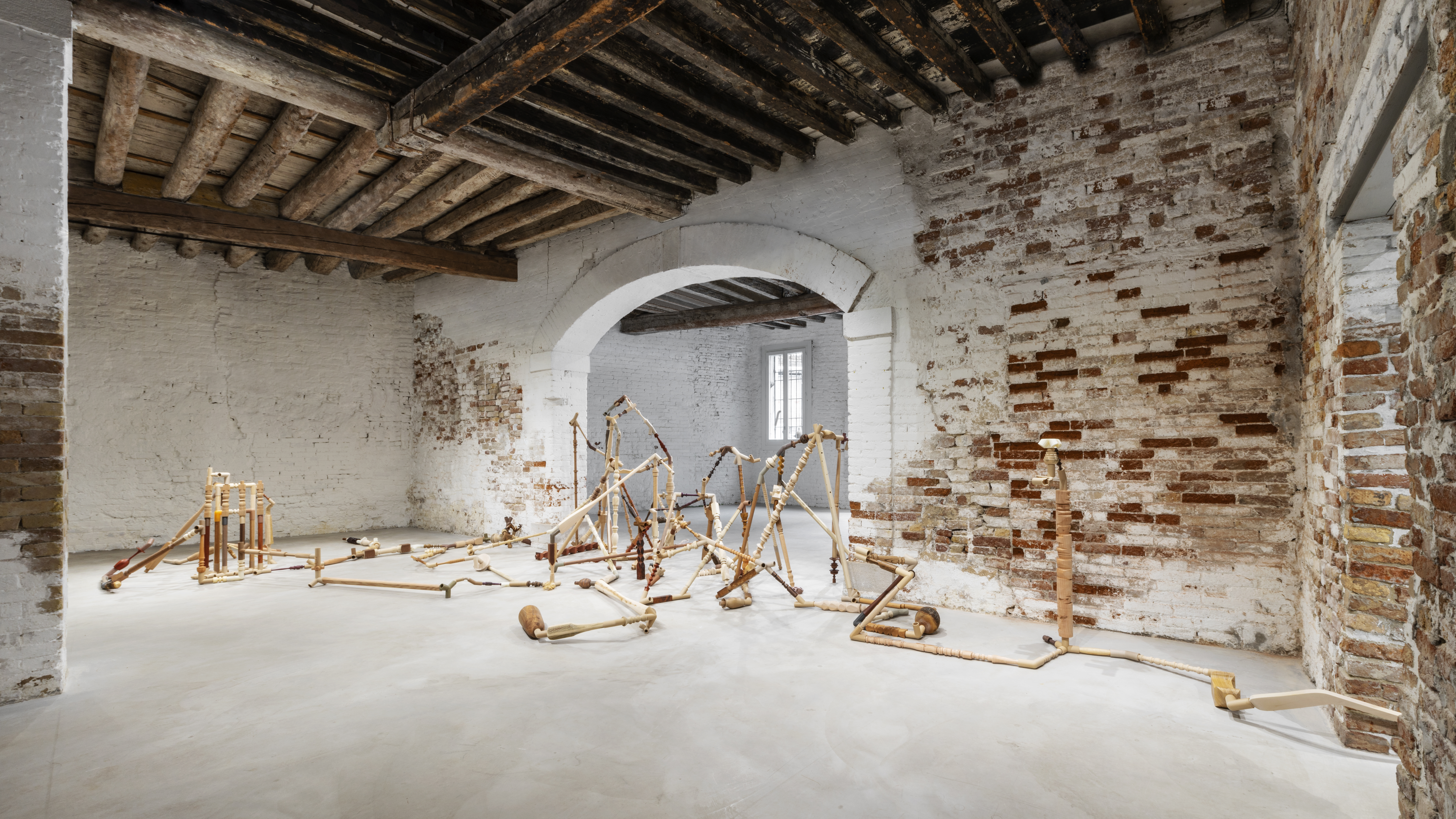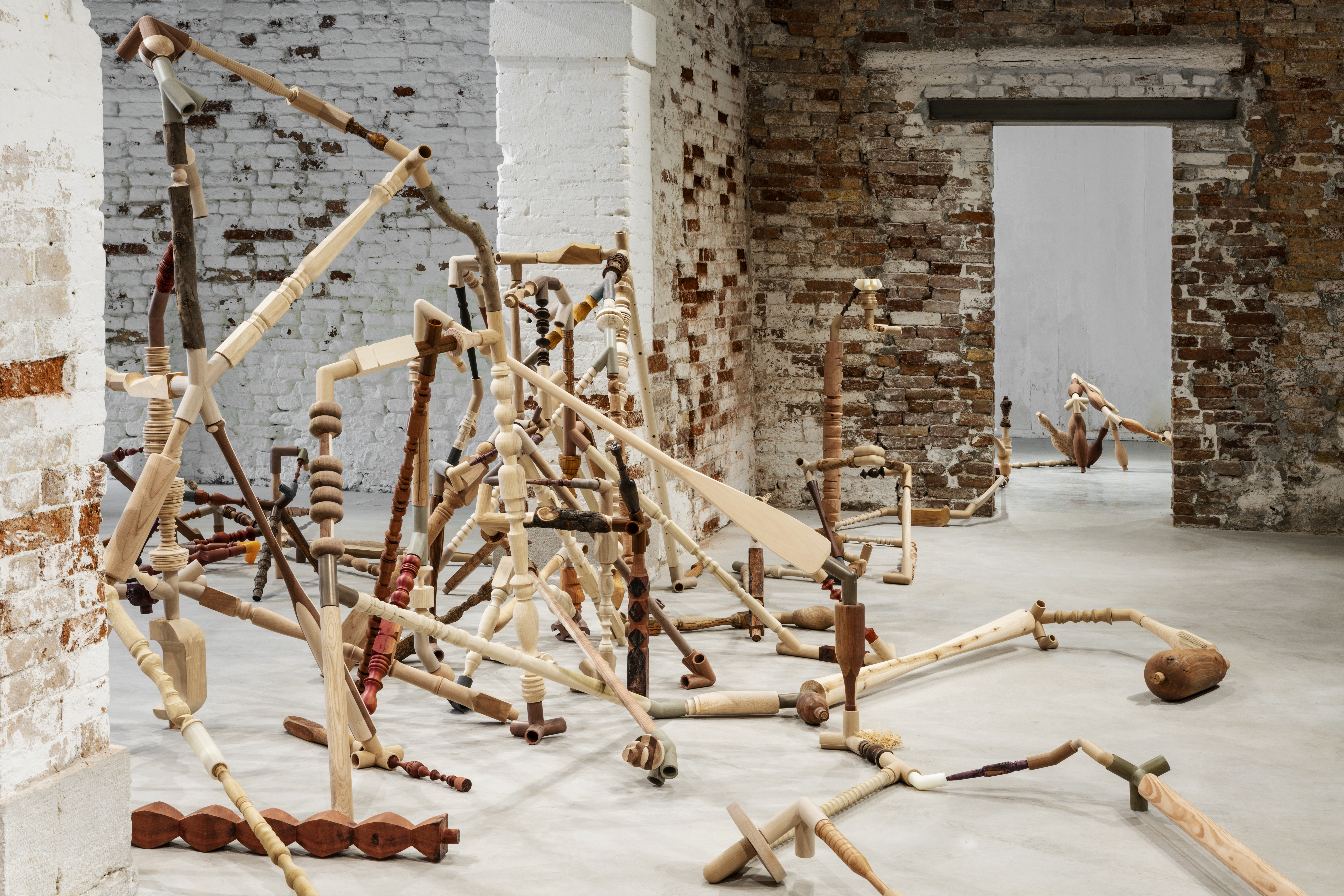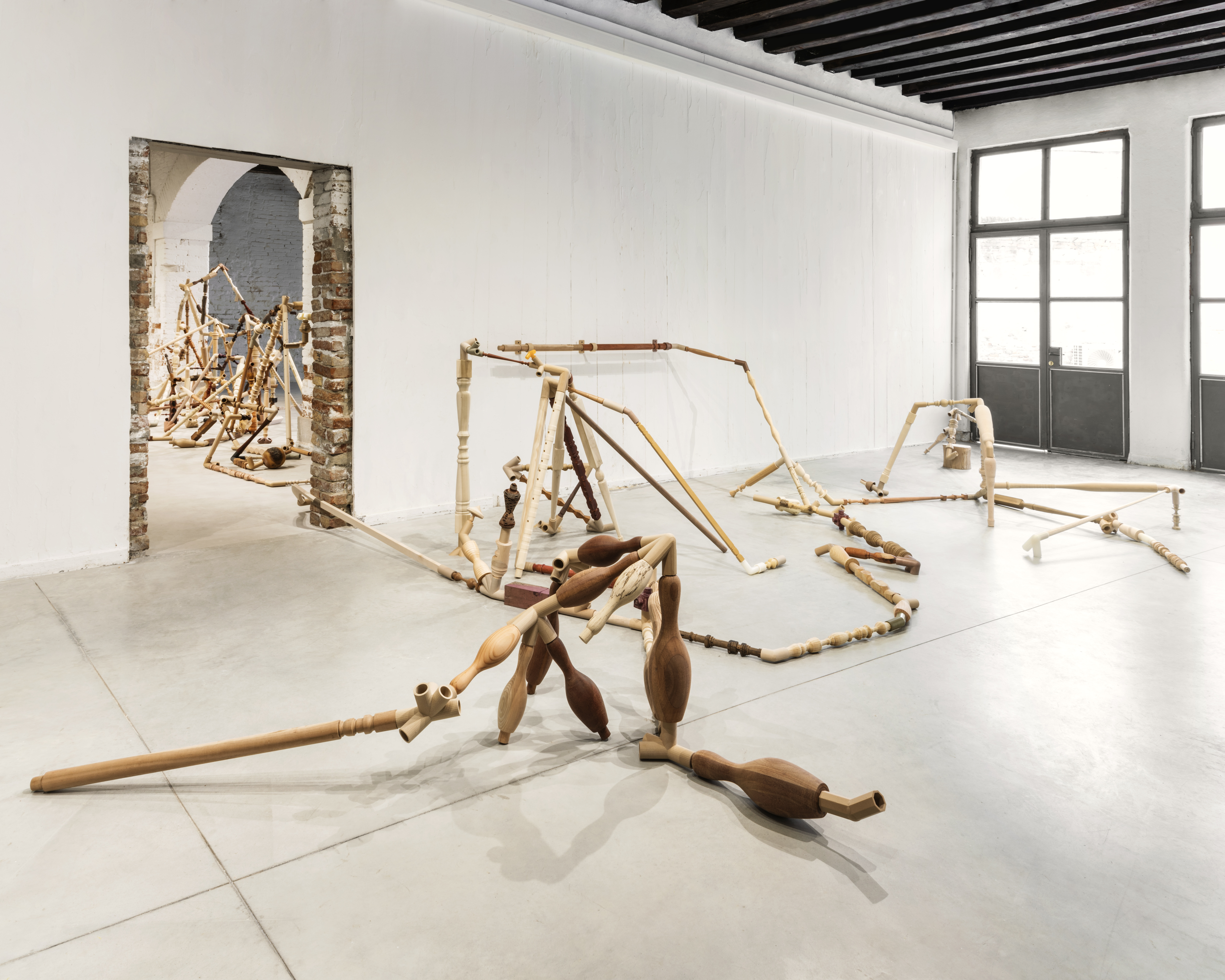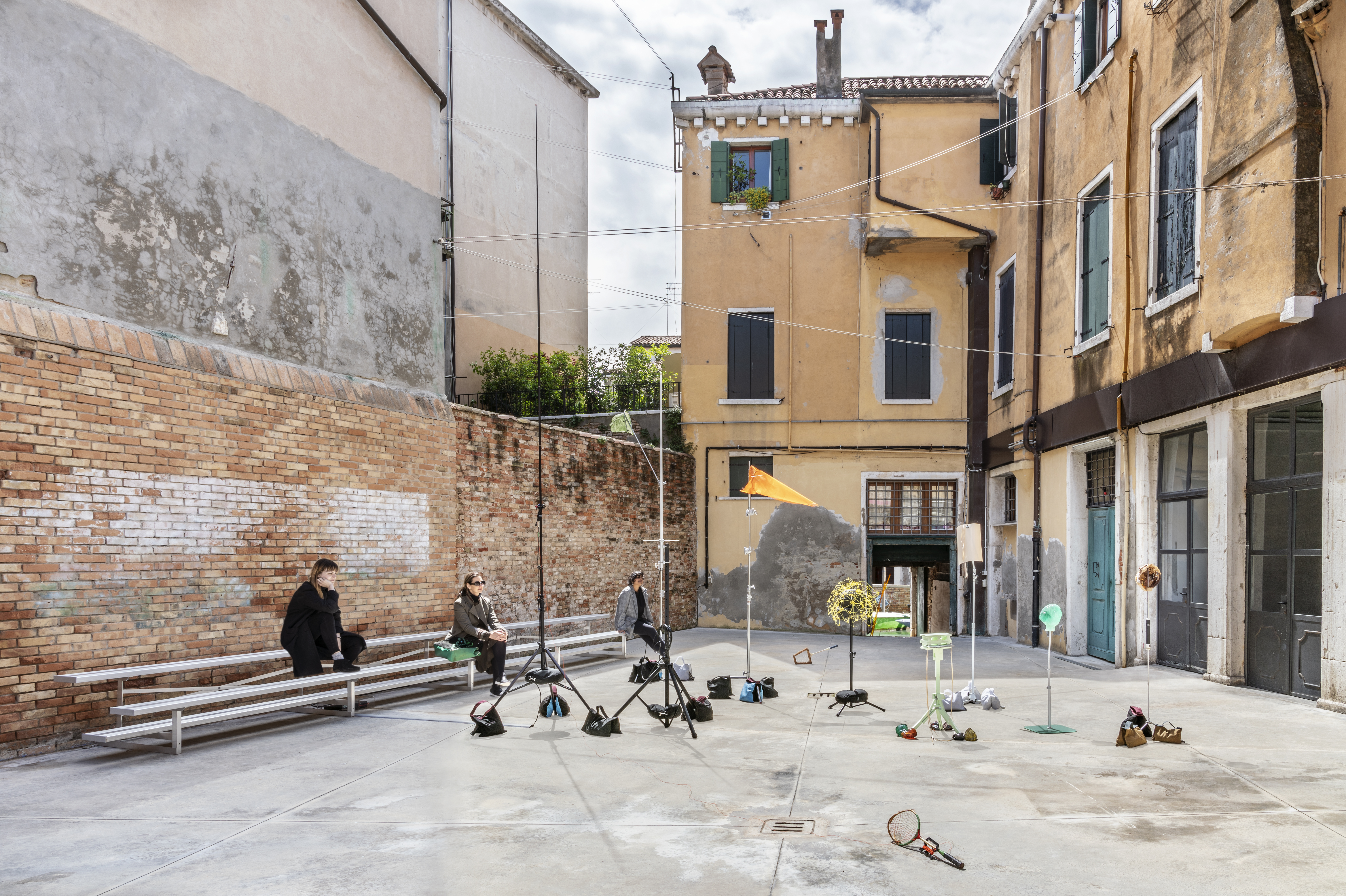“Stakeholders: Hong Kong in Venice” and the Hong Kong Protest Movement
by Violet Lin

Negotiated Differences, 2019. Photo: Ela Bialkowska. Courtesy of M+ and Shirley Tse.
Shirley Tse’s two-part installation, Stakeholders, Hong Kong in Venice was Hong Kong’s Collateral Event at the 58th Venice Biennale, guest-curated by Christina Li and co-organized by M+, West Kowloon Cultural District, and the Hong Kong Arts Development Council. One piece is the sprawling, intricate system of interconnected sculptural parts that makes up Negotiated Differences, installed in an interior space formerly used as a wood storage site. The other is Playcourt, an accompanying outdoor and vertical installation composed of various anthropomorphic markers of colonial-era labor, migration, and trade, including sports equipment and vanilla beans.
Shirley Tse’s recognition as the first female artist to represent Hong Kong at the Venice Biennale marks a cultural shift at a moment of acute political uncertainty in her hometown. Since early June 2019, over a million protesters have taken to the streets nearly every weekend to demand freedoms threatened by Hong Kong’s approaching reintegration with mainland China, set for 2047. While the movement has been leaderless and diverse in approach, employing a variety of collaborative tactics and the philosophical guidance of Bruce Lee’s famous dictum “be water,” protestors’ five core demands have remained consistent: “a formal withdrawal of the now-abandoned extradition bill which first sparked the current crisis; amnesty for those arrested; a commission of inquiry into the use of force by police; a retraction of protests being characterized as riots; and the revival of the city’s stalled political reform process.”1
These ongoing protests are the largest to date since Hong Kong’s handover to China from British colonial rule in 1997. The Hong Kong District Council elections in November 2019 saw a record voter turnout of nearly three million people, namely 71% of registered voters, with Hong Kong’s pro-democracy camp gaining control of 17 of the 18 District Councils, the largest in the camp’s history. While this landslide victory — a veritable taking of political temperature of the Hong Kong public after over half a year of unrest — has legitimized the voice of protestors and given way to a slight lull in demonstrations, so far only the first of their demands has been met and the future of Hong Kong remains unclear.
The material give and take in Tse’s work, notably in Negotiated Differences, performs a similar labor to that of the protest movement; it represents a coming together of disparate physical bodies — light, heavy, handmade, and machine-made — held in an act of suspension necessitating careful collaboration with the laws of gravity. Tse uses advanced 3D printing technology (what she calls “the 21st century ready-made”) to sculpt everyday materials — wood, plastics, metal — into multi-socket joints that connect various hand-turned wooden forms to create an intricate modular landscape. The resulting sensation is one of support and interconnectivity within an elaborate framework of heteronomous parts. Meanwhile, the negotiated differences of Hong Kong’s protest movement are unfolding in real time — impossible to categorize under a single ethical or political vision, yet steadily linked through the shared stake of maintaining Hong Kong’s relative democracy. The peaceful demonstration of August 23, referred to as “The Hong Kong Way,” brought together an estimated 210,000 protestors who formed a 60km human chain across the city’s famous Lion Rock Mountain and elsewhere throughout Hong Kong. Stakeholders mirrors the visions of sweeping, rhizomatic possibility contained in such demonstrations — negotiation on a citywide scale.
Negotiated Differences points toward a capacity for multiplicity, both material and abstract. Tse’s assorted wooden forms produce a horizontal sculptural network spread across three rooms and appearing to hover a few feet above the ground. The work itself evades any fixed or determined state, lending instead to a plasticity in which multiple subjectivities coexist. The viewer’s body is also implicated in this widespread system as it navigates the work’s structural landscape and moves around the space. It would be an impossible task to take in Negotiated Differences from a single vantage point. In relationship to the viewer, the work constantly shifts, never settling into a single static position — interlinked objects refusing objectivity.
Tse has long been fascinated with quantum physics, which she actively explores in her performative series, “Quantum Shirley” (2009 – ongoing). To borrow a term from quantum theory, one can imagine the observer effect taking place here: the phenomena (in this case, “an ever-growing organism, a rhizome extending itself across galleries, wrapping around corners, blocking passageways, and crawling up walls”2 changes under the gaze of the observing eye. The viewer, too, is changed by the encounter. One cannot help but draw connections to a cityscape — in constant flux, observable not as a whole but only in parts, and made up of individual interactions, conversations, and activity. Tse refers to certain pre-planned sections of Negotiated Differences as “clusters.” These clusters are predetermined in the artist’s studio, but how each will ultimately connect upon installation must be choreographed on site in an improvisational labor that adapts to the architecture at hand. One such cluster resembles a bowling pin exploding in mid-air — a loose representation of a minute interval of time superposed into a series of interacting objects caught in flight.3Perhaps counterintuitively, the system of support that runs between each cluster cannot be planned; rather, it is a process of physical deliberation, trial, and error.
A continent over from Venice, in Hong Kong, the cooperation of hundreds of thousands of politically invested bodies echoes the theoretical investigations at play in Negotiated Differences. As it happens, Tse (whose work consistently engages with continental philosophy, specifically in its investigation of phenomenology and perception) came to theory not through the lens of art history but through activism. In an interview for Hyperallergic she explains of her work, “I don’t want to only put different things together side by side. I want them to have action, to interlink. They actually have to work together, so to speak, to form an integrated whole.”4It is precisely this kind of active connection that resonates so intimately with Hong Kong’s current state and civil resistance as a whole — disparate bodies working together to form a larger, congruent voice. And in the tradition of previous Hong Kong Biennale artists, in May 2020 the exhibition will travel to Tse’s hometown to be adapted to the architecture of Hong Kong’s M+ Pavilion, collapsing the geographical distance between the work and the “real world.” Across the board, stakes are high.
Meanwhile, outside the exhibition hall in Venice, Tse’s companion work, Playcourt — an abstract badminton court — sets a parallel representational system into motion, drawing from colonial and familial histories of trade, labor, and migration. Through the conflation of various sports paraphernalia — badminton rackets, shuttlecocks made of cast rubber and vanilla beans, a HAM radio, and studio equipment — a loosely indicated sports arena comes to life in a picturesque Venetian courtyard. Its verticality draws the viewer’s sightline upward to the colorful laundry lines backed by brick and sky. Badminton, a sport made popular in Hong Kong under British colonial rule, takes the spotlight in this in-media-res staging of an imagined match. The resulting configuration hovers in an evocative in-betweenness, as if it has not yet been fully set up. As in Negotiated Differences, this improvisational quality underscores Tse’s consistent emphasis on plasticity and indeterminacy, making space for shifts in meaning and welcoming multiple interpretations. While the work evokes the artist’s personal memories of playing badminton in the street as a child, this reference to the sport also has broader implications. To Tse, it is a way of reclaiming space and access to collective pleasure by transporting an imported colonial pastime into the public realms of Hong Kong.
The verticality of Tse’s representational badminton match, with its tall stands supporting synthetic pastel objects, each characterized by their specific materiality — net, foam, plastic, etc. — directs our gaze to the clothing lines above. Playcourt reminds us of our proximity to the domestic space, our positioning at the intersection of public and private. From under the empty bleachers at the edge of the courtyard (signifying an imagined audience), distinct sounds emanate from a small HAM radio tuned to an amateur radio station. The subtle presence of these airwaves reproduces a gesture similar to that of the laundry lines and badminton court — reclamation of air space for universal use. These tactics demonstrate everyday ways of interacting with and regaining what is public, an act that has particularly powerful political ramifications in the Special Administrative Region of Hong Kong, which exists in a state of 50 years “borrowed time” allotted by the Sino-British Joint Declaration — not quite post-colonial, not quite a democracy. The work contains more direct nods to the region and to Tse’s familial history too — a badminton racket painted with Hong Kong’s colonial name, Victoria; and shuttlecocks made of Tahitian vanilla bean pods from the farm where Tse’s aunt worked while Tse was growing up (or “shuttlepods,” as Tse has referred to them)5. To the observant eye, and to Hongkongers and international visitors alike, Playcourt reveals the way in which colonial resources might be transformed into modes of play through deceivingly simple actions, and with radical and empowering repercussions.
Tse was born in Hong Kong in 1968. She was raised there under British colonial rule, leaving for the US in 1990, seven years before Hong Kong’s handover to China as stipulated by the Sino-British Joint Declaration. The treaty, signed by the People’s Republic of China and United Kingdom in 1984, outlined Hong Kong’s rights to a high level of autonomy, including freedom of speech, press, assembly, and rule of law. (It was the Sino-British Joint Declaration that drew attention after the Chinese foreign ministry declared it “a historical document that no longer has any realistic meaning” in July 2019.)6) Tse studied fine art at Chinese University in Hong Kong, participating in an exchange at UC Berkeley that introduced her to Californian life and critical theory. She considered pursuing a PhD in philosophy before attending ArtCenter for her MFA, and has since positioned sculpture as “a model for multi-dimensional thinking” — a way of working through philosophical questions in three-dimensional space. Drinking tea in her studio, Tse reflected, “I knew that if I went for philosophy … a lot of my thinking would have to be done through language. I think language has a lot of plasticity to it, but on the other hand, to me it is quite linear and limited … I want to think through my body.” Over time, her practice has evolved from a focus on the materiality of plastics and polymers as signifiers of globalization toward a more semantic investigation of plasticity and polysemy. In a similar shift, Tse’s interest in multiplicity has naturally progressed into questions of negotiation and the social body.
Tse’s move to Los Angeles was also a way of fleeing what she describes as the “cultural desert” of Hong Kong in the late ‘80s. Long seen as Asia’s economic hub, particularly for Western markets, the city’s business-oriented model bred a culture focused on economy, wealth, and material success while leaving a void in the arts. In Tse’s view, this encouraged a widespread apolitical attitude regarding social issues, though she senses a shift in the younger generation, who are more politically active than their predecessors.7While Tse admits Los Angeles “suffers from the stereotype of plastic artificial bodies bathed in eternal sunshine,”8 mirroring the materialism she deplored in the Hong Kong of her youth, she has also found it home to a unique community of artists. “One can be left alone to do their own thing, yet we do come together for collaboration, exchange of ideas, and mutual support if we want to. Approaches that are unorthodox get to see the light of day.” For Tse, Los Angeles represents the de-centering of 21st century contemporary art — a sprawling yet supportive network.
Back in Venice, the protests escalating in Tse’s hometown cast Stakeholders into a new light, transforming the scene from playful negotiation to a timely representation of violent clashes between police and protestors, and foregrounding the fragility of Hong Kong’s governance. In her essay for the exhibition catalog, “One Thing Connected to Another: Shirley Tse’s Sculptural Theory of Collectivity,” published before the onset of the protests, Miwon Kwon writes: “Tse’s whimsical puzzle-like sculptural installation harbors profound insights into how human collectivity, perhaps even democracy, might be accomplished, through respecting and accommodating differences rather than compromising or collapsing them into a uniform sameness.” This allusion to democracy might now be read as a premonition of the unrest to come. The collaborating sculptural forms of Negotiated Differences, each with their own limitations and individual properties, reflect a city struggling to retain its democratic freedoms. In an email correspondence, Tse wrote to me of one of her pieces in Playcourt, entitled Emulsion Not Solution: “I believe two differences (like oil and vinegar) can come together holding each other in suspension, as in an emulsion (e.g. salad dressing), without having to be dissolved into one solution.” Tse’s work suggests that the capacity for multiplicity and heterogeneity — and perhaps by extension, a healthy democracy — does not always require a resolution of differences, but a negotiation of them.
China ceded Hong Kong to the United Kingdom after the first opium war in 1847, commencing a 150-year period of British rule. In 1997, the handover of Hong Kong established a “one country, two systems” model and the implementation of the Basic Law, which serves as Hong Kong’s constitution. As outlined in the Sino-British Joint Declaration, this was to be followed by a 50-year period of relative autonomy for Hong Kong, in which it would retain certain freedoms before being completely reabsorbed by Chinese governance in 2047. Although 2047 is nearly 30 years away, many Hongkongers feel that China is already asserting control through media censorship, the disqualification of elected leaders, and the jailing of activists.9 The extradition bill proposed by pro-Beijing Chief Executive Carrie Lam in February 2019 was the final straw, unleashing the largest civil resistance movement in Hong Kong history.
Despite the withdrawal of the bill in October, opposition continues to build in Hong Kong. At the same time, protests are becoming increasingly difficult to follow through media outlets. What began with peaceful demonstrations, inspiring “Lennon Walls” to blossom all over the city, has now turned hostile on both sides. Mobsters beat civilians in a subway station near a protest in July, and police shot an 18-year-old protestor during China’s 70-year celebration of Communist rule in September. These developments have in turn prompted a small minority of protestors to become increasingly violent.
However, even the protestors’ most destructive acts have remained in accordance with their core demands — destroying surveillance cameras, defacing businesses associated with the triad society or Chinese banks, and vandalizing subway stations closed by the Metro Transit Railway Corporation in an effort to dissuade civilians from attending protests. Tse recently clarified her perspective on these actions by protestors to me in an email:
“They don’t loot. They resist arrest by fighting back the police and people who’ve picked fights at Lennon Walls. I do not condone any acts of violence at all. I think they perceive the laws aren’t there to protect people’s basic rights anymore (beating, tortures at police stations, arrests without due process, and alleged collusion between police and triads, etc.) and so they don’t want to sit and get arrested, but resort to all sorts of sabotages that have bad optics. It is a sad situation.”10
Still, the vast majority of protestors remain peaceful — in many cases creatively so — as they respond to the challenges of organized dissent under China’s authoritarian government. In Tse’s words, “They are rewriting the civil disobedience playbook.”
Tse has been tracking the protests closely from her home in Los Angeles. It is no surprise that many details from her work continue to be reflected in unforeseen ways within Hong Kong’s developing events. In her studio, Tse showed me a news video of protesters using badminton rackets to extinguish tear gas canisters thrown by police — an improvisational strategy employed to recoup their turf. Additionally, during a sit-in at the Hong Kong International Airport, protestors used a HAM radio to listen in on air traffic controllers. A Lennon Wall popped up by the entrance to the Stakeholders exhibition in Venice. For the upcoming installation of Playcourt in Hong Kong, Tse plans to add more real-time references, such as a beanie inscribed with the words an quan, meaning “safe,” that she acquired in China — a nod to the safety helmets that protestors have been wearing. During a press conference in August, Carrie Lam also aptly referred to protestors as “a small minority with no stake in society.”11If the affect-driven collectivist logic of Tse’s ever-evolving sculptural networks is any indicator, they are far from waning in number or scope. And they are more than willing to negotiate, if not resolve, their differences — bound, as it were, by a shared stake.





